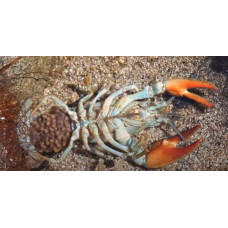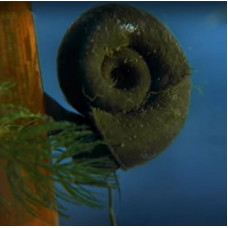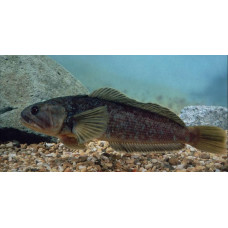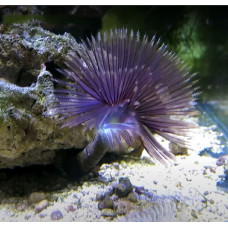Fauna of the Amundsen Sea
 Location of the Amundsen Sea
Location of the Amundsen Sea
A marginal sea of the Pacific Ocean off the coast of West Antarctica. It is bounded in the north by a conventional line from Cape Dart in the west to Cape Flying Fish in the east, with the other boundaries following the predominantly icy coasts of the continent. In the eastern part, it extends far into the coast at Marie Byrd Land. The coastlines are high, mountainous, and rugged in the eastern part: the large Pine Island Bay, King, Canisteo, Bair, and Martin Peninsulas. The Thwaites Glacier and the Getz Ice Shelf face the sea. The area is 98 thousand km2. The average depth is 286 m, the maximum depth is not known. The shelf is slightly inclined towards the sea, is a slightly undulating accumulation plain, separated from the deep waters by a submarine sill with depths of 400-500 m above it. The continental slope is steep and flat and extends to depths of 4,000 meters. The seafloor is practically untraceable.
Climate of the Amundsen Sea
The Amundsen Sea is located in the Antarctic climate zone. Cold continental air prevails over the sea throughout the year. It is open to the north and communicates freely with the waters of the Pacific Ocean along its entire length. In winter (July-August), mainly westerly, easterly and southeasterly winds blow over the sea with speeds of 5-8 m/s, often with storm force (30-35 m/s), storm frequency is up to 40%. The average air temperature is minimum in July, falling from -18 ºC in the north to -28 ºC in the south, and from -35 to -50 ºC in stormy southerly winds. In summer (January - February), the winds over the sea are predominantly westerly, often southerly, with a speed of 5-6 m/s, with rare easterly gales reaching 30 m/s. During the relatively warm summer months, air temperatures drop from -8 ºC in the north to -16 ºC in the south, and from -20 to -24 ºC in the coldest years.
Water of the Amundsen Sea
The Antarctic hydrological type of water structure is widespread in the Amundsen Sea. Due to the predominance of depths down to 500 m, Antarctic surface water dominates the sea. In winter, the sea is completely ice-covered and the surface water temperature is about -1.5 ºC in the northern part and about -1.8 ºC in the southern part; from the horizon of 50-70 m and to the bottom, the temperature decreases on average to 0.5 ºC and in the northernmost part to -1.5 ºC. In summer, the sea is almost completely covered by drift ice, with small areas of clear water formed only off the coast by winds blowing from the mainland; the surface water temperature rises to 0.0 ºC, rarely to 1.0 ºC. The vertical distribution of water temperature in areas permanently covered by ice is nearly uniform with depth; only in ice-free areas does the temperature decrease slightly with depth. Salinity at the surface and at depth varies within small limits; in winter under ice it is 34.00-34.25‰, in summer it decreases to 33.0‰ (due to desalination during ice melting). In addition to the drift ice in this sea, there is perennial land-fast ice that covers all of Pine Island Bay. From the coast of Antarctica, continental ice fragments enter the sea and form icebergs, which move out of the sea with the drifting ice toward Drake Passage. Surface currents are formed under the influence of prevailing winds, the circulation of adjacent ocean waters, and the configuration of the Antarctic coastline. The general water transport is from east to west in the form of the Coastal Antarctic Current. The tides are semidiurnal with a height of about 1 m.
Inhabitants of the Amundsen Sea
The harsh climate and cold make this region of Antarctica uninhabitable. The Amundsen Sea is home to a single family of fish, the notothenes. These are mainly bottom-dwelling fish that can also live close to shore, such as scaly rockcod and Antarctic toothfish. They are prey for penguins and albatrosses. Sometimes dolphins, killer whales and whales swim out to sea. The most common whale in this sea is the minke whale. Ross seal, Weddell seal, leopard seal are also found here. Of the exotic inhabitants, sea cucumbers, starfish and sea urchins live here. There are crustaceans, mollusks, cnidarians, bryozoans, ophiuroids and polychaetes in the area.
Antarctic toothfish
Latin nameDissostichus mawsoniOther namesAntarctic codIdentificationFirst dorsal fin with 7-9 barb r..
Crustaceans
Crustacea is a class of invertebrates of the Arthropoda type. It includes animals with body length f..
Mollusca
A type of secondary invertebrate. Probably originated in the Precambrian; several classes of mollusc..
Nototheniidae
Nototheniidae is a family of fishes of the order Perciformes. 15 genera, more than 50 species (gray,..
Polychaeta
Class of ringed worms. Known since the Cambrian. Most live in the sea - on the bottom, near the bott..
Scaly rockcod
Latin nameTrematomus loennbergiiOther nameTrematomus loennbergiiIdentificationThe body of the Scaly ..






